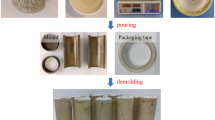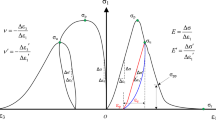Abstract
Pulse hydraulic fracturing is an effective fracturing stimulation technology, which can reduce rock breakdown pressure and improve fracturing effects. Under pulse hydraulic loading, fatigue damage occurs in the rock, and the rock strength gradually deteriorates. However, the characteristics of rock strength deterioration and rock fracture mechanisms under different pulse hydraulic pressures are not clear, and the fracture model induced by strength deterioration has not been well established. In this study, strength deterioration tests are carried out under different pulse hydraulic pressures, and tensile strength deterioration curves are obtained. We introduce the strength deterioration curve in the continuous discontinuous element method (CDEM) to establish the fracture damage deterioration model of rocks, and implement crack propagation using the improved cohesion zone model. The validity of the fracture damage deterioration model is verified by comparison with the test results. During pulse hydraulic loading, the hydraulic pressure of pulse loading can influence fatigue tensile strength and hydraulic fracture propagation behaviors. With the decrease of pulse loading stress ratio, the fatigue tensile strength gradually decreases, resulting in more fractures in the specimen. Under different pulse loading stress ratios, with the increase of pulse loading numbers, the damage tensile strength of the specimen decreases gradually. When the pulse loading stress ratio is low, the degree of damage to the tensile strength decreases significantly, which easily induces rock failure and increases the fracturing effect.
Highlights
-
A fracture damage deterioration model is proposed for rock failure under pulse hydraulic fracturing.
-
The rock strength deterioration characteristics and rock failure mechanisms under different pulse hydraulic pressures are investigated.
-
The fracture damage deterioration model is introduced in the CDEM to simulate the rock failure under pulse hydraulic fracturing.
-
By simulating hydraulic fracture propagation behaviors under different pulse loading conditions, the rock failure mechanism is revealed.














Similar content being viewed by others
Data availability
The data that support the fingdings of this study are available from the corresponding author upon reasonable request.
References
Beugelsdijk LJL, Pater C, Sato K (2000) Experimental hydraulic fracture propagation in a multi-fractured medium. In: SPE Asia Pacific Conference on Integrated Modelling for Asset Management SPE-59419-MS
Biot MA, Willis DG (1957) The elastic coefficients of the theory of consolidation. J Appl Mech 24:594–601
Bohloli B, Pater C (2006) Experimental study on hydraulic fracturing of soft rocks: Influence of fluid rheology and confining stress. J Pet Sci Eng 53:1–12
Chen M, Jiang H, Zhang GQ, Jin Y (2010) The experimental investigation of fracture propagation behavior and fracture geometry in hydraulic fracturing through oriented perforations. Pet Sci Technol 28:1297–1306
Chitrala Y, Moreno C, Sondergeld C, Rai C (2013) An experimental investigation into hydraulic fracture propagation under different applied stresses in tight sands using acoustic emissions. J Pet Sci Eng 108:151–161
Daisuke A, Pengzhi P, Kimikazu T, Mikio T, John EB (2018) Simulating hydraulic fracturing processes in laboratory-scale geological media using three-dimensional TOUGH-RBSN. J Rock Mech Geotech Eng 10:98–107
Dehghan AN, Goshtasbi K, Ahangari K, Jin Y, Bahmani A (2017) 3D numerical modeling of the propagation of hydraulic fracture at its intersection with natural (pre-existing) fracture. Rock Mech Rock Eng 50:367–386
Elices M, Guinea GV, Gómez J, Planas J (2002) The cohesive zone model: advantages, limitations and challenges. Eng Fract Mech 69:137–163
Fatahi H, Hossain MM, Sarmadivaleh M (2017) Numerical and experimental investigation of the interaction of natural and propagated hydraulic fracture. J Nat Gas Sci Eng 37:409–424
Feng C, Li S, Liu X, Zhang Y (2014) A semi-spring and semi-edge combined contact model in CDEM and its application to analysis of Jiweishan landslide. J Rock Mech Geotech Eng 6:26–35. https://doi.org/10.1016/j.jrmge.2013.12.001
Gao Y, Liu Z, Zeng Q, Wang T, Zhuang Z, Hwang KC (2017) Theoretical and numerical prediction of crack path in the material with anisotropic fracture toughness. Eng Fract Mech 180:330–347
González JM, Zárate F, Oate E (2018) Pulse fracture simulation in shale rock reservoirs: DEM and FEM–DEM approaches. Comb Pattern Match 5:355–373
Guo T, Zhang S, Qu Z, Zhou T, Xiao Y, Gao J (2014) Experimental study of hydraulic fracturing for shale by stimulated reservoir volume. Fuel 128:373–380
Haimson B (1968) Hydraulic fracturing in porous and nonporous rock and its potential for determining in-situ stresses at great depth. Ph.D. thesis, University of Minnesota
Haimson B (1978) The hydrofracturing stress measuring method and recent field results. Int J xRock Mech Min Sci Geomech Abstr 15(4):167–178
Haimson B, Fairhurst C (1967) Initiation and extension of hydraulic fractures in rock. Soc Pet J 7(03):310–318
Jesse H, Marte G, Luis M, Dandan H, Luke M (2018) Acoustic emission characterization of microcracking in laboratory-scale hydraulic fracturing tests. J Rock Mech Geotech Eng 10:805–817
Ji YL, Zhuang L, Wu W, Hofmann H, Zang A, Zimmermann G (2021) Cyclic water injection potentially mitigates seismic risks by promoting slow and stable slip of a natural fracture in granite. Rock Mech Rock Eng 54:5389–5405
Ju Y, Liu P, Chen J, Yang Y, Ranjith PG (2016) CDEM-based analysis of the 3D initiation and propagation of hydrofracturing cracks in heterogeneous glutenites. J Nat Gas Sci Eng 35:614–623
Kehle RD (1964) Determination of tectonic stresses through analysis of hydraulic well fracturing. J Geophys Res 69:250–273
Li Q, Lin B, Zhai C, Ni G, Shen P, Chen S (2013) Variable frequency of pulse hydraulic fracturing for improving permeability in coal seam. Int J Min Sci Technol 23:847–853
Li Q, Lin B, Zhai C (2014) The effect of pulse frequency on the fracture extension during hydraulic fracturing. J Nat Gas Sci Eng 21:296–303
Liu Z, Chen M, Zhang G (2014) Analysis of the influence of a natural fracture network on hydraulic fracture propagation in carbonate formations. Rock Mech Rock Eng 47:575–587. https://doi.org/10.1007/s00603-013-0414-7
Liu LL, Cai GJ, Zhang J, Liu XY, Kai L (2020) Evaluation of engineering properties and environmental effect of recycled waste tire-sand/soil in geotechnical engineering: A compressive review. Renew Sustain Energy Rev 126:109831
Lu P, Li G, Huang Z, Tian S, Shen Z (2014) Simulation and analysis of coal seam conditions on the stress disturbance effects of pulsating hydro-fracturing. J Nat Gas Sci Eng 21:649–658
Lu P, Li G, Huang Z, He Z, Li X, Zhang H (2015) Modeling and parameters analysis on a pulsating hydro-fracturing stress disturbance in a coal seam. J Nat Gas Sci Eng 26:253–263
Ma XF, Zhou YS, Li N, Chen M, Zhang YN, Liu ZZ (2017) Experimental study on the mechanism of hydraulic fracture growth in a glutenite reservoir. J Struct Geol 97:37–47
Mahrer KD (1999) A review and perspective on far-field hydraulic fracture geometry studies. J Pet Sci Eng 24:13–28
Mateusz J, Baotang S, Mikael R (2019) Simulation of the interactions between hydraulic and natural fractures using a fracture mechanics approach. J Rock Mech Geotech Eng 11:1138–1150
Rbeawi SA, Tiab D (2013) Pressure behaviours and flow regimes of a horizontal well with multiple inclined hydraulic fractures. Int J Oil Gas Coal Technol 6:207–241
Slutz J, Anderson J, Broderick R, Horner P (2012) Key shale gas water management strategies: an economic assessment. In: Society of Petroleum Engineers SPE-157532-MS
Valkó P, Economides MJ (1994) Propagation of hydraulically induced fractures—a continuum damage mechanics approach. Int J Rock Mech Min Sci Geomech Abstr 31:221–229
Wang Y, Tonon F (2009) Modeling Lac du Bonnet granite using a discrete element model. Int J Rock Mech Min Sci 46:1124–1135
Wang T, Zhou W, Chen J, Xiao X, Li Y, Zhao X (2014) Simulation of hydraulic fracturing using particle flow method and application in a coal mine. Int J Coal Geol 121:1–13
Wei C, Zhang B, Zhu W, Wang S, Lin C (2020) Fracture propagation of rock like material with a fluid-infiltrated pre-existing flaw under uniaxial compression. Rock Mech Rock Eng 54:875–891
Wei C, Zhang B, Li S, Fan Z, Li C (2021) Interaction between hydraulic fracture and pre-existing fracture under pulse hydraulic fracturing. SPE Prod Oper 36(03):1–19
Wu DY, Yu LY, Ju MH, Li SC, Liu RC, Su HJ, Zhou LJ (2022) Study on the mode I fracture properties of granites after heating and water cooling treatments under different impact loadings. Rock Mech Rock Eng 55:4271–4290
Xi X, Yang S, Mcdermott CI, Shipton ZK, Fraser-Harris A, Edlmann K (2021) Modelling rock fracture induced by hydraulic pulses. Rock Mech Rock Eng 54:3977–3994
Xie J, Xie J, Ni G, Rahman S, Sun Q, Wang H (2020) Effects of pulse wave on the variation of coal pore structure in pulsating hydraulic fracturing process of coal seam. Fuel 264:116906
Xu J, Zhai C, Qin L (2017) Mechanism and application of pulse hydraulic fracturing in improving drainage of coalbed methane. J Nat Gas Sci Eng 40:79–90
Yan T, Li W, Bi X (2011) An experimental study of fracture initiation mechanisms during hydraulic fracturing. Pet Sci 8:87–92
Yu LY, Fu A, Yin Q, Jing H, Zhang T, Qin H (2020) Dynamic fracturing properties of marble after being subjected to multiple impact loadings. Eng Fract Mech 230:106988. https://doi.org/10.1016/j.engfracmech.2020.106988
Zhai C, Yu X, Xiang X, Li Q, Wu S, Xu J (2015) Experimental study of pulsating water pressure propagation in CBM reservoirs during pulse hydraulic fracturing. J Nat Gas Sci Eng 25:15–22. https://doi.org/10.1016/j.jngse.2015.04.027
Zhao Q, Lisjak A, Mahabadi O, Liu Q, Grasselli G (2014) Numerical simulation of hydraulic fracturing and associated microseismicity using finite-discrete element method. J Rock Mech Geotech Eng 6:574–581
Zhou L (2013) A new numerical 3D-model for simulation of hydraulic fracturing in consideration of hydro-mechanical coupling effects. Int J Rock Mech Min Sci 60:370–380
Zhou L, Hou MZ (2013) A new numerical 3D-model for simulation of hydraulic fracturing in consideration of hydro-mechanical coupling effects. Int J Rock Mech Min Sci 60:370–380. https://doi.org/10.1016/j.ijrmms.2013.01.006
Zhu X, Feng C, Cheng P, Wang X, Li S (2021) A novel three-dimensional hydraulic fracturing model based on continuum–discontinuum element method. Comput Methods Appl Mech Eng 383:113887. https://doi.org/10.1016/j.cma.2021.113887
Zhuang L, Kim KY, Jung SG, Diaz M, Min KB, Zang A, Stephansson O, Zimmermann G, Yoon JS, Hofmann H (2019) Cyclic hydraulic fracturing of pocheon granite cores and its impact on breakdown pressure, acoustic emission amplitudes and injectivity. Int J Rock Mech Min Sci 122:104065
Zhuang L, Jung SG, Diaz M, Kim KY, Hofmann H, Min KB, Zang A, Stephansson O, Zimmermann G, Yoon JS (2020) Laboratory true triaxial hydraulic fracturing of granite under six fluid injection schemes and grain-scale fracture observations. Rock Mech Rock Eng 53:4329–4344
Zhuang L, Zang A, Jung S (2022) Grain-scale analysis of fracture paths from high-cycle hydraulic fatigue experiments in granites and sandstone. Int J Rock Mech Min Sci 157:105177
Acknowledgements
This paper is funded by the National Natural Science Foundation of China (NO. 52179118, 51879151 52109129).
Author information
Authors and Affiliations
Corresponding author
Ethics declarations
Conflict of Interest
The authors have no conflicts of interest to declare that are relevant to the content of this article.
Additional information
Publisher's Note
Springer Nature remains neutral with regard to jurisdictional claims in published maps and institutional affiliations.
Rights and permissions
Springer Nature or its licensor (e.g. a society or other partner) holds exclusive rights to this article under a publishing agreement with the author(s) or other rightsholder(s); author self-archiving of the accepted manuscript version of this article is solely governed by the terms of such publishing agreement and applicable law.
About this article
Cite this article
Wei, C., Li, S., Yu, L. et al. Study on Mechanism of Strength Deterioration of Rock-Like Specimen and Fracture Damage Deterioration Model Under Pulse Hydraulic Fracturing. Rock Mech Rock Eng 56, 4959–4973 (2023). https://doi.org/10.1007/s00603-023-03313-3
Received:
Accepted:
Published:
Issue Date:
DOI: https://doi.org/10.1007/s00603-023-03313-3




